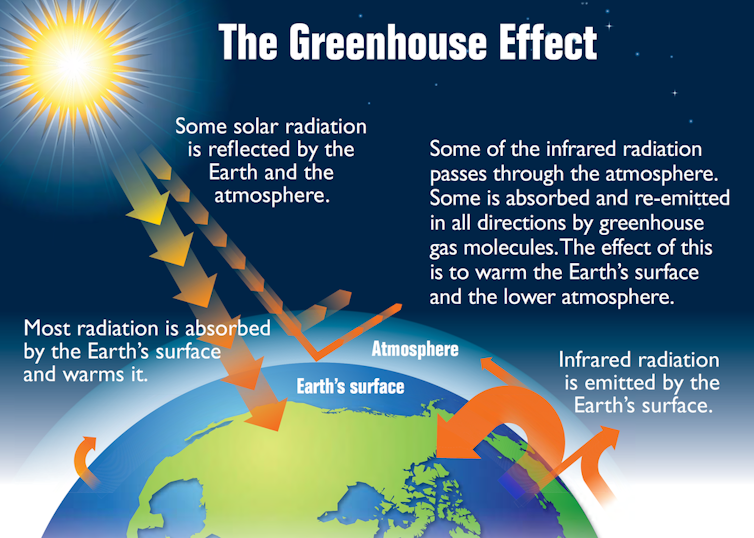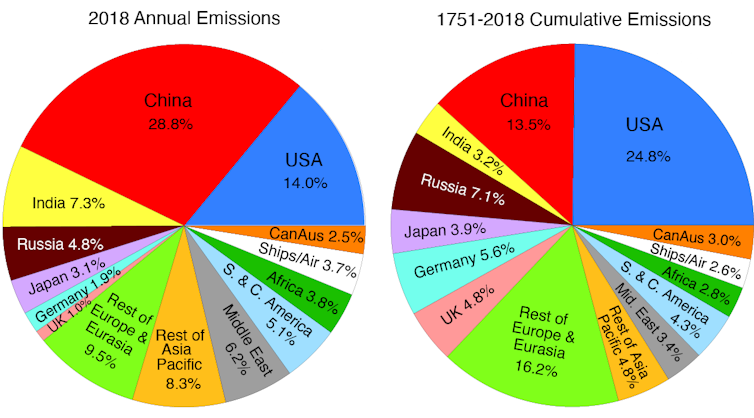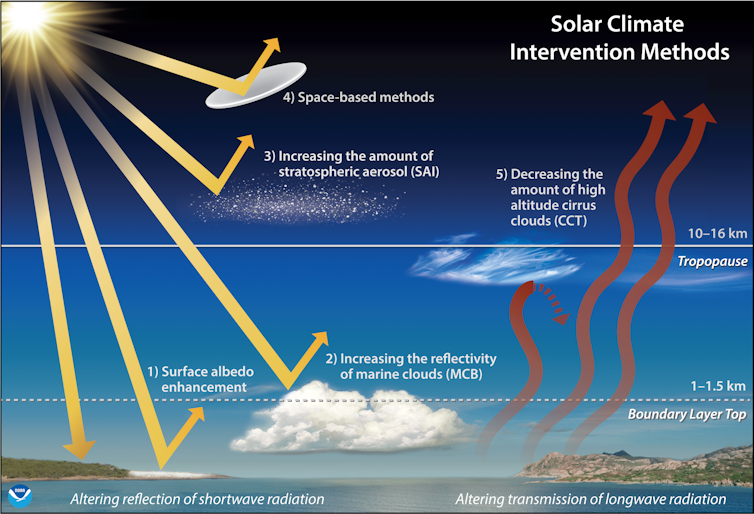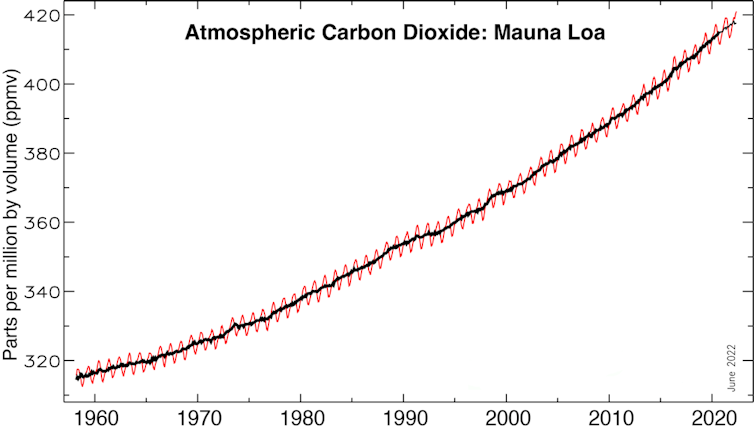
When politicians talk about reaching “net zero” emissions, they’re often counting on trees or technology that can pull carbon dioxide out of the air. What they don’t mention is just how much these proposals or geoengineering would cost to allow the world to continue burning fossil fuels.
There are many proposals for removing carbon dioxide, but most make differences only at the edges, and carbon dioxide concentrations in the atmosphere have continued to increase relentlessly, even through the pandemic.
I’ve been working on climate change for over four decades. Let’s take a minute to come to grips with some of the rhetoric around climate change and clear the air, so to speak.
What’s causing climate change?
As has been well established now for several decades, the global climate is changing, and that change is caused by human activities.
When fossil fuels are burned for energy or used in transportation, they release carbon dioxide—a greenhouse gas that is the main cause of global heating. Carbon dioxide stays in the atmosphere for centuries. As more carbon dioxide is added, its increasing concentration acts like a blanket, trapping energy near Earth’s surface that would otherwise escape into space.
When the amount of energy arriving from the Sun exceeds the amount of energy radiating back into space, the climate heats up. Some of that energy increases temperatures, and some increases evaporation and fuels storms and rains.

Because of these changes in atmospheric composition, the planet has warmed by an estimated 1.1 degrees Celsius (2 F) since about 1880 and is well on the way to 1.5 C (2.7 F), which was highlighted as a goal not to be crossed if possible by the Paris Agreement. With the global heating and gradual increases in temperature have come increases in all kinds of weather and climate extremes, from flooding to drought and heat waves, that cause huge damage, disruption, and loss of life.
Studies shows that global carbon dioxide emissions will need to reach net-zero carbon emissions by midcentury to have a chance of limiting warming to even 2 C (3.6 F).
Currently, the main source of carbon dioxide is China. But accumulated emissions matter most, and the United States leads, closely followed by Europe, China, and others.

What works to slow climate change?
Modern society needs energy, but it does not have to be from fossil fuels.
Studies show that the most effective way to address the climate change problem is to decarbonize the economies of the world’s nations. This means sharply increasing use of renewable energy—solar and wind cost less than new fossil fuel plants in much of the world today—and the use of electric vehicles.
Unfortunately, this changeover to renewables has been slow, due in large part to the huge and expensive infrastructure related to fossil fuels, along with the vast amount of dollars that can buy influence with politicians.
What doesn’t work?
Instead of drastically cutting emissions, companies and politicians have grasped at alternatives. These include geoengineering; carbon capture and storage, including “direct air capture”; and planting trees.
Here’s the issue:
Geoengineering often means “solar radiation management,” which aims to emulate a volcano and add particulates to the stratosphere to reflect incoming solar radiation back to space and produce a cooling. It might partially work, but it could have concerning side effects.
The global warming problem is not sunshine, but rather that infrared radiation emitted from Earth is being trapped by greenhouse gases. Between the incoming solar and outgoing radiation is the whole weather and climate system and the hydrological cycle. Sudden changes in these particles or poor distribution could have dramatic effects.

The last major volcanic eruption, of Mt. Pinatubo in 1991, sent enough sulfur dioxide and particulates into the stratosphere that it produced modest cooling, but it also caused a loss of precipitation over land. It cooled the land more than the ocean so that monsoon rains moved offshore, and longer term it slowed the water cycle.
Carbon capture and storage has been researched and tried for well over a decade but has sizable costs. Only about a dozen industrial plants in the U.S. currently capture their carbon emissions, and most of it is used to enhance drilling for oil.
Direct air capture—technology that can pull carbon dioxide out of the air—is being developed in several places. It uses a lot of energy, though, and while that could potentially be dealt with by using renewable energy, it’s still energy intensive.
Planting trees is often embraced as a solution for offsetting corporate greenhouse gas emissions. Trees and vegetation take up carbon dioxide though photosynthesis and produce wood and other plant material. It’s relatively cheap.
But trees aren’t permanent. Leaves, twigs, and dead trees decay. Forests burn. Recent studies show that the risks to trees from stress, wildfires, drought, and insects as temperatures rise will also be larger than expected.
How much does all this cost?
Scientists have been measuring carbon dioxide at Mauna Loa, Hawaii, since 1958 and elsewhere. The average annual increase in carbon dioxide concentration has accelerated, from about 1 part per million volume per year in the 1960s to 1.5 in the 1990s, to 2.5 in recent years since 2010.
This relentless increase, through the pandemic and in spite of efforts in many countries to cut emissions, shows how enormous the problem is.

Usually carbon removal is discussed in terms of mass, measured in megatons—millions of metric tons—of carbon dioxide per year, not in parts per million of volume. The mass of the atmosphere is about 5.5×10¹⁵ metric tons, but as carbon dioxide (molecular weight 42) is heavier than air (molecular weight about 29), 1 part per million volume of carbon dioxide is about 7.8 billion metric tons.
According to the World Resources Institute, the range of costs for direct air capture vary between $250 and $600 per metric ton of carbon dioxide removed today, depending on the technology, energy source and scale of deployment. Even if costs fell to $100 per metric ton, the cost of reducing the atmospheric concentrations of carbon dioxide by 1 part per million is around $780 billion.
Keep in mind that the carbon dioxide concentration in the atmosphere has risen from about 280 parts per million before the industrial era to around 420 today, and it is currently rising at more than 2 parts per million per year.
Tree restoration on one-third to two-thirds of suitable acres is estimated to be able to remove about 7.4 gigatons of carbon dioxide by 2050 without displacing agricultural land, by WRI’s calculations. That would be more than any other pathway. This might sound like a lot, but 7 gigatons of carbon dioxide is 7 billion metric tons, and so this is less than 1 part per million by volume. The cost is estimated to be up to $50 per metric ton. So even with trees, the cost to remove 1 part per million volume could be as much as $390 billion.
Geoengineering is also expensive.
So for hundreds of billions of dollars, the best prospect is a tiny dent of 1 part per million volume in the carbon dioxide concentration.
This arithmetic highlights the tremendous need to cut emissions. There is no viable workaround.
Kevin Trenberth is a Distinguished Scholar at the National Center for Atmospheric Research in Boulder, Colo., and an affiliate faculty member at the University of Aukland in New Zealand. This post was originally published at The Conversation.
Weekly Newsletter
Get building science and energy efficiency advice, plus special offers, in your inbox.















11 Comments
This sounds pretty grim but it's probably accurate. I hear pundits from Fox News complaining about Joe Biden's cynical attempt to con us into creating a big government green energy program that will bankrupt the taxpayer and cause inflation/recession. And the poor pitiful citizens of this country think right-on, it's just a cynical ploy to take away the god given right of an individual for complete dominion over the planet, despite any scientific facts that might argue for reining that in. We're a plague on the planet and Fox News is the organized religion that seems to be the pulse that drives that plague. Fox News followers should finally admit that they invent facts to back up their existing beliefs and prejudices rather than creating beliefs based on observable facts. Even our primitive ancestors that dwelled in caves had belief systems that were much more in tune and symbiotic to their environment than the beliefs of the present Republican party. They are bat-shit crazy.
Yes if its one thing climate alarmists/hysterics have been over the last 40 years its accurate.(eye rolls). Trust the science right? Serve the billionaire authoritarians because they have your best interests at heart right? You should watch more CNN/MSNBC
I have no reason to disbelieve the analysis in this article. I'll try to be more polite than my previous comment even though the information in this beautifully written article is upsetting. The reason it's so upsetting is that if you read between the lines just a little bit it means we have a very small window of opportunity to act. Yet the usual suspects, which I've mentioned, are trying to squash the last opportunity we may ever get.
To get a feeling for how seriously I take the information in the article, if I was just starting a family I would reconsider. At this point it might be a very selfish decision that will doom your progeny, and perhaps theirs, to a very difficult and perhaps short life, at least statistically speaking. There are always statistical exceptions. It's kind of like that joke where a scientist is writing an equation on a board and at some point in the equation he writes "a miracle happens here". That's how I see your view of the improbability of global disaster happening if we stay on the same course adding CO2 to the atmosphere.
exeric,
We live in a post-truth world. It's a suckers game trying to argue with climate deniers.
Yeah, I know. I can't help myself. It may seem like I don't censure myself, but I do. I've learned to censure myself on questions that are merely academic. You actually helped me with that. This isn't merely academic, though.
It seems that you are making things up. If by the "climate alarmists" you mean scientists that have made predictions based on the models they have produced, they haven't made outrageous claims about what would happen during these past forty years. However, they have warned us about likely developments if the world remains on the same path. Their models, as of this point, are largely correct, and the outlook for the future is not positive, to put it mildly. So what is your reasoning based upon? And who are the billionaire authoritarians that you speak of? Do they control the scientists?
.
Great article, a gift to have it here on GBA. Can't be precise but I believe some of the carbon capture and storage schemes (ethanol) rely on government subsidy to get moving. This cost to the public must be considered. We can also restore some marginal cropland to native vegetation to help slow the CO2 trajectory.
"As has been well established now for several decades, the global climate is changing, and that change is caused by human activities."
Actually this hasn't been well established and it's a laugh riot that the guy who famously said "The fact is that we can’t account for the lack of warming at the moment and it is a travesty that we can’t," and then said it must be in the deep oceans (which we unsurprisingly can't measure).
Here's a guy who in private says "Where's the extra heat?" yet won't say it in public, presumably because he'd likely not get any more grant money if he actually admitted in public the things he says in private.
https://judithcurry.com/2013/03/29/has-trenberth-found-the-missing-heat/
Do you have any arguments less than nine years old? A lot has been researched and published since then.
https://theconversation.com/2022s-supercharged-summer-of-climate-extremes-how-global-warming-and-la-nina-fueled-disasters-on-top-of-disasters-190546
This is my latest article. ENJOY
Log in or create an account to post a comment.
Sign up Log in